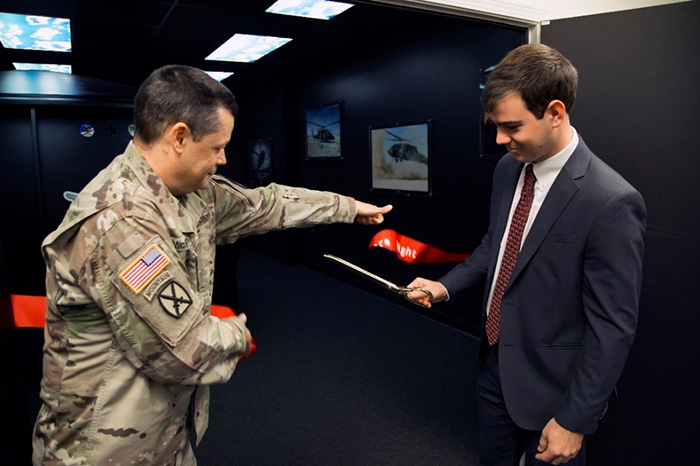Futuristic Flight Technology Gives Vertical Lift Researchers a Boost

FORT RUCKER, Ala. – The U.S. Army Aeromedical Research Laboratory (USAARL) introduced an innovative Blackhawk helicopter simulator at a ribbon-cutting ceremony on September 17 at Fort Rucker, Alabama. The Cockpit Academics Procedural Tool– Enhanced Visual Capable System – or, CAPT-E-VCS for short– is a reconfigurable research platform that allows for swift, mission-responsive research in support of the Army's Future Vertical Lift and modernization priority. These priorities are part of the Army's focus on multi-domain operations to counter and defeat near-peer advisories in all domains.
"USAARL is the Army's aeromedical laboratory focused on the performance and survival of the rotary wing Warfighters to give them decisive overmatch," said USAARL's Commander, Col. Mark K. McPherson, about the importance of fielding state-of-the art tools in research. "This high fidelity simulator is the perfect example of how we merge the science of aviation and medicine to optimize human protection and performance, leveraging science against our nation's competitors."

The Army views vertical lift dominance over enemy forces as critical to increased lethality, survivability and reach. To meet the demands of Future Vertical Lift priorities, the Army is both developing and acquiring next-generation aircraft and unmanned systems to fly, fight and prevail in any environment. The CAPT-E-VCS was developed in partnership with the U.S. Army Combat Capability Development Command's System Simulation, Software, & Integration Directorate to evaluate new technologies integral to meeting those requirements. The device pairs a Blackhawk medium-lift model helicopter cockpit and academic simulator from California-based SGB Enterprises with a 12-inch projection dome from Q4 Services, Inc., which is headquartered in Orlando, Florida. State-of-the-art X-IG image generation software – developed by Alabama-based CATI Training Systems– was further added to the CAPT-E-VCS in order to create a singular, customizable research platform for USAARL.
"Now we can evaluate in a digital glass cockpit platform pilot workload as well as the effects of high altitude flight environments," said Dr. Mike Wilson, Research Psychologist at USAARL. "For example, we can couple the laboratory's reduced oxygen breathing device with a high-fidelity simulation environment and create a more realistic test environment for research. This innovation is a mission responsive, cost saving research tool that is critical to moving the Army closer to its Future Vertical Lift goals."














